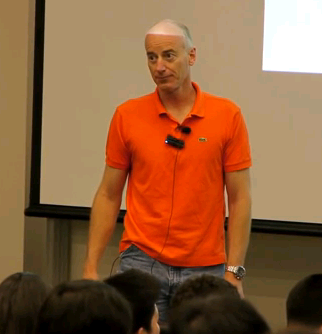UCI Chem 131C Thermodynamics and Chemical Dynamics (Spring 2012)
Lec 07. Thermodynamics and Chemical Dynamics -- Vibrational Partition Functions --
View the complete course: ../courses/chem_131c_thermodynamics_and_chemical_dynamics.html
Instructor: Reginald Penner, Ph.D.
License: Creative Commons BY-NC-SA
Terms of Use: ../info.
More courses at http://ocw.uci.edu
Description: In Chemistry 131C, students will study how to calculate macroscopic chemical properties of systems. This course will build on the microscopic understanding (Chemical Physics) to reinforce and expand your understanding of the basic thermo-chemistry concepts from General Chemistry (Physical Chemistry.) We then go on to study how chemical reaction rates are measured and calculated from molecular properties. Topics covered include: Energy, entropy, and the thermodynamic potentials; Chemical equilibrium; and Chemical kinetics. This video is part of a 27-lecture undergraduate-level course titled "Thermodynamics and Chemical Dynamics" taught at UC Irvine by Professor Reginald M. Penner.
Thermodynamics and Chemical Dynamics (Chem 131C) is part of OpenChem: ../openchem/
Recorded on April 16, 2013.
Index of Topics:
00:05 - Introduction: Vibrational Partition Functions
00:17 - Quiz 2 Histogram
00:41 - The Symmetry Number
04:14 - We also get this answer using my approach.
07:09 - Aluminum Chloride Atoms Example
09:45 - We also get this answer using my approach (Diagram example)
13:03 - What is the symmetry number of: benzene?
15:43 - Estimate the rotational partition function for HCl...
16:09 - Linear molecules lacking a center of symmetry:
16:41 - Estimate the rotational...(formula)
19:12 - Calculate the rotational partition function for methane.
22:02 - Vibrational States
23:23 - ...including the zero point energy, we have...
24:52 - this geometric series has the form:
25:40 - how big is...
28:04 - Example: The triatomic molecule, chlorine dioxide (OCIO) has three vibrational modes...
31:42 - Graph: What Does the T-dependence...look like?
32:45 - Of course, molecular dissociation would occur before...
32:58 - thinking about the partition functions at room temperature, we conclude...
33:24 - What about vibrational energy?
35:13 - E=RT, Equipartition Theorum
36:13 - Here's a midterm exam question from a couple of years ago:
37:55 - Midterm exam solution
39:10 - Equations Page of Exam
41:03 - Calculations and Solution
41:40 - If you are asked: calculate the fractions of molecules for which...
42:25 - Calculations: ("now one mole of...)
44:47 - Example
45:07 - B. Now one mole of...
45:18 - Example (as in 44:47)
Required attribution: Penner, Reginald Thermodynamics and Chemical Dynamics 131C (UCI OpenCourseWare: University of California, Irvine), ../courses/chem_131c_thermodynamics_and_chemical_dynamics.html. [Access date]. License: Creative Commons Attribution-ShareAlike 3.0 United States License.


